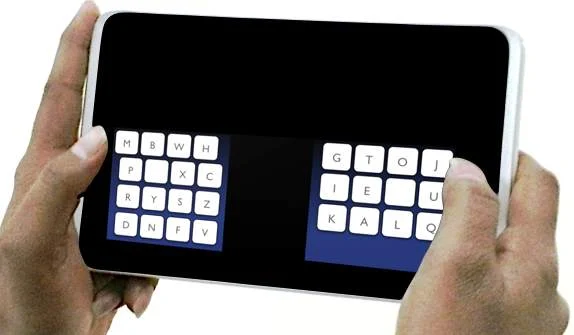The research team of Antti Oulasvirta at the Max Planck Institute for Informatics has created a new keyboard dubbed “KALQ” that enables signficantly faster thumb-typing on touchscreen devices.
The team utilized used computational optimization techniques in conjunction with a model of thumb movement to search among millions of potential layouts before identifying one that yields superior performance. Indeed, after a short amount of practice, the average user could type 34% faster than with a QWERTY layout.

Typing on today’s mobile phones and tablets is needlessly slow. One limitation is that the QWERTY layout is ill-suited for tablets and other touchscreen devices when typing with the thumbs. Two-thumb typing is ergonomically very different from typing on a physical keyboard.
To be sure, normal users using a QWERTY on a touchscreen device are limited to typing at a rate of around 20 words per minute, which is slow compared to the rates achieved on physical keyboards. As such, Max Planck researchers set out to create an alternative to QWERTY that offers substantial performance advantages for users by incorporating models of thumb movement into a computational optimization algorithm.
Of course, slight changes to the layout, like exchanging a few keys, would not be sufficient for a significant improvement. Words like “on, see, you, read, dear, immune, based”, frequently used in texts, have to be typed on a split-QWERTY layout with a single thumb only, making the typing burdensome. This initiated the process to develop a layout for two-thumb text entry with the goal of improving typing performance and minimizing the strain for the thumbs.
“The key to optimizing a keyboard for two thumbs is to minimize long sequences with a single thumb. We also want to place frequently used letters centrally close to each other,” explained Antti Oulasvirta.
“Experienced typists move their thumbs simultaneously: While one is typing, the other is approaching its next target. We derived a predictive model of this behaviour for the optimization method.”
According to Oulasvirta, the above-mentioned computational optimization process had two goals: To minimize the moving time of the thumbs and to approximate alternating sides as well as possible. The result achieved by computational optimization was rather unexpected.
Meaning, in the new keyboard KALQ, all vowels, with the exception of the letter “y”, are placed in the area for the right thumb, whereas the left thumb gets assigned more keys. To fully benefit from this layout, the users were trained to move their thumbs simultaneously. While one thumb is typing, the other one can move to its next target.
“The legacy of QWERTY has trapped users with suboptimal text entry interfaces on mobile devices. However, before abandoning QWERTY, users rightfully demand a compelling alternative,” said Per Ola Kristensson.
“We believe KALQ provides a large enough performance improvement to give users the incentive to switch and benefit from faster and more comfortable typing.”
The researchers also developed probabilistic error correction methods that take into account how thumbs move and also statistical knowledge about the texts users type. To be sure Their error correction method enable trained users to type more quickly while retaining an acceptable level of errors.
With these improvements, users were able to reach 37 words per minute, which is the best ever reported for two-thumb typing on touchscreen devices, significantly more than the approximate 20 words on a split QWERTY that regular users can achieve.






